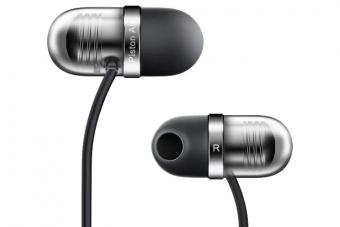Hello!
Today in the review of 3 inexpensive popular power banks with Aliexpress. Powerbanks, of course, this is loudly said, because. they are sold without the batteries themselves, i.e. in fact, only a box and a converter board. I bought them at different times, but now I decided to do parallel testing, measure the output current and the overall efficiency of work.
I'll start with the cheapest, designed for one 18650 cell. Inside, I set the cell to 2200 mAh, i.e. actual power 8.14 Wh. Next, I measure the number of given mAh on discharge after a full charge and received on charging with further conversion to W-hours. This will allow you to estimate the efficiency of the device.
And so, after a full charge, this power bank gave 1395 mAh, which is approximately 6.98 Wh. Therefore, we can estimate the efficiency of the circuit by dividing this value by the capacity of the battery and multiplying by 100 to convert it to a percentage.
Efficiency = 100 * 6.98 / 8.14 = 85.8%

On return, this power bank consistently gives 1A, which allows you to charge most modern smartphones and tablets.

In general, a good device, given its cost, even low efficiency is not a problem, provided that a high-quality 18650 lithium-ion cell is used.

Next, I turn to a review of a power bank for 2 18650 things. This box is a little more powerful and is able to charge batteries with a current of 1A, and give 1.5 A to the output. In principle, it is. Real figures correspond. True, the tension sags quite strongly.

I determine the efficiency similar to the first option. In the PB itself, I installed two cells with a total capacity of 4150 mAh, which is approximately 15.36 W-hours.

On discharge, the device gave out 2670 mAh, which is approximately 13.35 Wh, taking into account the nominal voltage of 5 V.
Efficiency = 100 * 13.35 / 15.36 = 86.91%
The recoil efficiency turned out to be almost the same as the first option, having interrupted the value by just a little more than a percent.
In addition to the main function of the power bank, this device has a built-in LED that acts as a flashlight. In addition, he knows how to give an S.O.S. signal, which is activated by long pressing the button.

It is worth paying attention to one more point, which is strongly recommended to be taken into account when operating the device. I don’t know if this is typical for all devices of this type or if this is a batch, but the battery overdischarge protection works with an error. In fact, the converter turns off when the voltage drops to 3 V. The blue LED indicating the connected load goes out.

At the same time, the USB port continues to receive voltage directly from the batteries, which contributes to their further discharge. I recorded a complete shutdown at a voltage of 2.4 V. This is too low a voltage for lithium batteries. This will not disable the batteries immediately, but they will significantly reduce their resource. Therefore, if your power bank will have a similar problem, then you should not allow a full discharge if you want the batteries to last longer.
After such a deep discharge, charging for some time goes on with a small current of the order of 0.1 A. Probably to raise the voltage to about 3 V, after which charging proceeds normally with a current of 1A.

And let's move on to the last copy of today's review. This PB is designed for 5 18650 lithium batteries.
Using 5 parallel batteries at once allows you to get 2A output even if you use not very fresh batteries. In my case, batteries are installed that are about 4 years old with a total capacity of 7377 mAh according to the latest measurements by the Lii-500 device. This is about 67% of their total face value.

This device is equipped with an LCD display that displays the percentage of charge. True, it does not change very evenly. Also on the display there is an indication of the load or charging with a current of 1A or 2A.

Charging by default occurs with a current of 1A. To switch to 2A, you must hold the button for about 2 seconds with the charger connected. The same action without charging will reset the device.

The flashlight is turned on by pressing the button twice.

With regard to the efficiency in discharging, this device pleased him with a high value. So, with a battery capacity of 27.3 W-hours, it was possible to drain as much as 26.24 W-hours to the output, which is approximately 96% of the capacity.
Efficiency = 100 * 26.24 / 27.3 = 96%

Such a result cannot but rejoice. There is almost nowhere better. In terms of efficiency, measurements were made only for port 2A, as more interesting. Probably for 1A other values can be obtained. Under load, a 1A port delivers about 0.95A, a 2A port delivers 1.83A, which is not bad and meets expectations.




Displayed parameters:
- USB output voltage
- USB output current

Equipment:
- USB cable - microUSB
 ">
">Portable Universal Charger (Power Bank) Power Reserve AMJ-V8-4
Use any unprotected Li-Ion 18650 batteries (not included). Get exactly the capacity you need!
Attention: do not use protected Li-ion batteries!

High quality spring-loaded contact pads provide a reliable electrical connection.

Two 5V USB outputs for 1A and 2A max, which can work simultaneously.
Charge your Power Bank from any 5V USB source with current up to 1A (USB-microUSB cable included)

Informative LCD display with backlight. Now you do not need to use additional devices to understand the voltage and current at the output of the Power Bank.
Displayed parameters:
- voltage of each installed battery:
- USB output voltage
- USB output current

Equipment:
- Power Bank (batteries not included)
- USB cable - microUSB

Discharged, and there is no outlet nearby? This situation is quite common, because modern smartphones are very “gluttonous” and quickly sit down if you use them actively enough. In such an unpleasant situation, the so-called "Power Bank", or in a simple way - portable charging, can come to the rescue. About one of these charges, which uses 2 18650 batteries in its composition - this review.
If someone else is "not in the know", I'll tell you what a Power Bank is.
In fact, it is a battery, but it was not created to power a particular device, but to give its energy to others. Power Bank must be charged in advance, and only then it can be used to charge almost any device that can be charged via a usb cable.
Now I’ll tell you a little about why “mobile chargers” on 18650 batteries are the most practical. The fact is that when buying such a charger only on the principle of “more mAh + smaller size”, you can never rely on the honesty of the manufacturer and, as a result, such a device, most often, will soon stop holding a charge and will be thrown into the trash, because. picking up and replacing a battery in it will be almost impossible due to its uniqueness.
The solution to this problem is the use of chargers, the power sources of which are batteries of the standard, generally accepted type 18650. Today, such batteries can be either purchased separately or, for example, removed from a failed laptop battery.
In this case, most often the battery controller is the cause of the malfunction, while the 18650 “banks” turn out to be quite functional and at the same time compare favorably with those purchased separately in their quality, because. laptops use only high-quality capacious batteries.
So, the hero of this review is a device designed to work with two 18650 batteries and, by the way, originally equipped with them by the manufacturer.
Specifications:
- Input voltage (Input): 5V 1A
- Output voltage (Output): 5V 1A
- Declared capacity: 5200 mAh
- Current capacity: 3600 mAh
- Dimensions: 46 x 96 x 23 mm
As you can see, the characteristics are rather mediocre, but here I want to focus on the capacity of the device. I have repeatedly noticed that many Chinese manufacturers are reluctant, but still begin to show the real capacity of their batteries. In this case, the manufacturer emphasizes that a loud 5200 mAh sign corresponds to a real 3600 mAh. By the way, we will check this further ...
The device is delivered in such a box, placed in a frame made of hard plastic
Package contents: the device itself, 2x18650 batteries and a short microUSB-USB cable
Batteries, judging by the appearance, belong to the well-known and widespread Chinese brand "NoName"))
Weight - not to say small, but nothing to say about the large capacity
The box itself looks quite attractive.
On the front there is an on / off button, as well as three LEDs for indicating the battery status. At the back are brief performance characteristics
There are two connectors on the top end:
- full USB - for connecting a device that needs to be recharged
- microUSB - for connecting an external power source and charging batteries
In order to pull out the battery compartment, holding on to the white case, press on the lower gray end of the device
Device weight without batteries
Batteries are inserted on spring-loaded contacts on the principle of conventional finger batteries
Device weight with batteries inserted
Apparently, the manufacturer did not set himself the task of making a big secret out of the electronics of the device, so if necessary, you can disassemble it quite simply by unscrewing just a few screws
To charge any device, such as a smartphone, you need to connect it using the supplied cable and press a single button
In this case, the current battery charge will be displayed using blue LEDs.
Puzzled by the problem of checking battery capacity at home, together with the monitored Power Bank, this one was ordered household usb tester, by no means claiming, however, to be a professional, but nevertheless quite suitable, judging by the reviews, for use at home ...
This device is connected “into the break” of the line through which charging is carried out and during the entire process it fixes the necessary values \u200b\u200bof the current and voltage passing through it, and also calculates the capacity of the device being charged.
This device has three connectors: USB - output, microUSB - input, USB tail, as well as a multifunctional control button for switching and erasing memory cells.
After a complete discharge, the Power Bank was put on charge through this tester and this is what happened in the end
You can see that the resulting capacity almost converges with the honestly declared 3600 mAh. Why "practically"? Because, nevertheless, the tester readings are not accurate enough due to the peculiarities of the capacitance measurement process, because. it is still correct to take measurements during discharging, and not charging the battery. In this regard, judging by the reviews, the tester readings may differ from the true ones by about 100-300 mAh in one direction or another.
Here, for example, is a measurement of the battery capacity of a smartphone with a declared value of 3000 mAh.
In conclusion, I’ll say that in general, this mobile charger is well suited as a backup power source, but if the expected time away from the outlet promises to be quite long, then you can always take a few charged 18650 batteries with you in reserve and change them in charging according to need.
Thank you for your attention.
Let them talk as much as they like about the fact that there is a magical power bank that gives the characteristics indicated on the package, but the most accurate is what you can assemble yourself. Armed with this very idea, I ordered a separate power bank case for myself and are already very famous for their quality. I ordered it, and when it arrived, I began my "research". In short, this is the best you can buy, accurate and reliable.
The case came in a package. 

The kit is the bank itself and the charging cord. The plug of this cord is ideal for routers, with the help of this particular cable I powered the router with YOTA from the power bank, so it’s a fairly common connector, and as a plus, there is always a backup battery to the router in case of a power outage. 
At first, having examined the bank, I was in amazement, since when ordering there should have been indicators, they were listed on the box, and in front of me was a one-piece monotonous case with a power button. 
I also looked at the bottom, there are specifications. 
2A for 2 USB ports is quite good parameters. Having connected the power, the indicators miraculously appeared.  On the front we see 2 USB ports and a port for charging with a cable from the kit.
On the front we see 2 USB ports and a port for charging with a cable from the kit. 
In it, I connected, beloved not only by me, batteries with protection from SANYO. Their tests have been done here many times and I will not waste your time on this. It looks like this. 
The insides look very presentable, nothing superfluous, everything is high quality and neat. That is, we have a bank for 4 batteries with protection, by the way, you can use ordinary batteries without protection, but I prefer not to save on this. I use the same batteries for a reason, if performance is needed, that's how it can be achieved. Weight with 4 batteries is 298 grams. Each battery is almost 2600 mAh, that is, we have 10400 mAh, we round this value taking into account the current conversion and we get a bank of 10000 mAh, completely honest with minimal weight and maximum compactness and efficiency. It is this power bank that I recommend to absolutely everyone, I myself use it for travel and in everyday situations, and it is unlikely that something ready-made can be compared. Thank you.
P.S. The meaning of the review is how to assemble something of your own, something that you can really rely on, without disputes in forums and measuring equipment, having obviously good batteries and a simple and reliable case.






